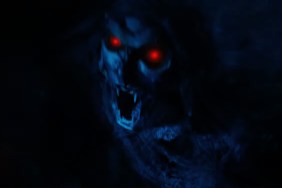James Hetfield
Lars Ulrich
Kirk Hammett
Bob Rock
Phil Towle
Robert Trujillo
Jason Newsted
Dave Mustaine
Story:
In 2001, the rock band Metallica parted ways with Jason Newsted, its bass player of eleven years. Realizing the problems within the band, they brought in therapist Phil Towle to help them get through the recording of their new album. Things are going well until a minor difference sends singer James Hetfield storming out of the studio. He ends up going into rehab to deal with his alcohol and anger issues brought to light by the therapy. When the band returns to the recording studio a year later, everything has changed. Documenting a rough transition period in this seminal band’s career, Some Kind of Monster asks the question how far a band has to go to stay together.
Analysis:
When directors Joe Berlinger and Bruce Sinofsky (Brother’s Keeper, Paradise Lost) began a promo film documenting the making of Metallica’s first album of original material in over five years, they probably didn’t expect that they would end up with such an amazing story. What starts as a making-of documentary quickly turns into a serious look into the politics and inner workings of a hugely successful and yet elusive rock band.
At the center of this “monster” is the clash of egos between singer James Hetfield and drummer Lar Ulrich, the two powerful personalities that formed the band in 1981. Their relationship is much like a marriage, but it revolves around the idea of putting the band over the individual, something that may be responsible for the band being so close to the breaking point. Their therapy sessions with Phil Towle provide Some Kind of Monster with some of the most revealing moments about the band, as they try to get to work out the problems. It’s amazing stuff to watch, as these sessions usually are private and it’s almost unheard of to film them, let alone for a commercial release. It’s a very daring move and the band takes a huge chance by allowing their fans to see them as real people with emotions and feelings.
Hetfield has his own personal demons to face, most notably his drinking and his fits of rage, and his eventual breakdown that sends him to rehab is foreshadowed in the movie’s first half hour. Despite his problems, Hetfield certainly comes across better than Ulrich, who seems so wrapped up in his art and music that it takes him longer to accept there are problems that need to be worked out. His epiphany comes in the form of Metallica’s former guitarist Dave Mustaine, who has a heart-to-heart with Ulrich about how he felt about being kicked out of the band before they hit it big. It’s the movies most surprising moment, considering Mustaine’s loudmouth reputation, but it’s also one of the many scenes that are a bit uncomfortable to watch. Current lead guitarist Kirk Hammett is the most laid back and zen of the group, not letting the squabbling get to him, although his passive attitude may account for his lack of input during his fifteen years.
At one point, it becomes obvious that the band has worn Towle out, but the band then has to make the tough decision to let him go, because he’s getting too involved in the band dynamics and trying to influence their work. When he starts to hand James ideas for lyrics, you can’t help but snicker due to the similarities to a scene in This is Spinal Tap.
Despite the numerous tangents, the movie never loses sight of what makes the band so popular-their music-and much of it is dedicated to the development of songs from their “St. Anger” album. Unlike their previous records, this one was more of a collaborative effort, written in the studio by the band with lead guitarist Kirk Hammett playing a much stronger role, with everyone helping Hetfield with the lyrics. Despite selling 4.5 million copies worldwide, the album was not as well received as some of the band’s past efforts, but it’s interesting to see the band trying new things.
The movie’s coverage of Metallica’s transitional phase is thorough, including the auditioning of new bass players before preparing for Hetfield’s first tour as a former alcoholic. Their new bassist Robert Trujillo brings freshness to the band, looking half the age of the rest of the band despite only being a few years younger. His is floored when he gets the gig, which comes along with a million dollar advance to get him up to speed with the rest of the group as well as his debut on MTV’s prestigious “Icon” tribute show.
The movie even follows the individual members of the band when they’re not in the studio. This makes it even clearer that the band has softened with age, as they’re shown taking care of their kids, and it may be hard for their fans to get into the way the movie trashes all the illusions of rock musicians being rowdy party animals. The movie also touches upon Newsted’s own career path with his new band, Echobrain, and his former bandmates even show up to his show.
Unlike other modern documentaries, Some Kind of Monster never tries to be clever with visuals or gags, sticking to the plan of documenting events as they unfold. That said, the opening credits showing the various incarnations of Metallica throughout their career playing their early song “Seek and Destroy” is a great example of the brilliant editing of the movie.
Still, at two and a half hours, the movie is way too long. Although a lot of it is interesting, it certainly could have been edited down with some of the extraneous stuff-like the band’s downtime hobbies-being saved for a later DVD release. Despite the lull that hits the movie two-thirds of the way through, it really comes together with Hetfield’s moving, heart-felt speech to the inmates of San Quentin prison before the band plays a gig there.
The Bottom Line:
Berlinger and Sinofsky have certainly upped the ante on the rock documentary by making this more than just a concert film or making-of movie. Whether or not it will be of interest to those who don’t have the slightest appreciation of Metallica may be questionable, but this is the first movie to really get into the intricacies of the recording process and how it is affected by band dynamics. Some Kind of Monster shows a true transformation, a real coming of age, as a band accepts what is wrong and makes a conscious effort to improve them, and more importantly, it brings a group of “rock gods” down to earth and makes them more human.










